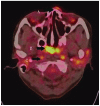Discerning primary tumors from metastases in synchronous nasopharyngeal squamous cell carcinoma and cutaneous squamous cell carcinoma: A case report and review of the literature
- PMID: 24765143
- PMCID: PMC3997691
- DOI: 10.3892/ol.2014.1915
Discerning primary tumors from metastases in synchronous nasopharyngeal squamous cell carcinoma and cutaneous squamous cell carcinoma: A case report and review of the literature
Abstract
Nasopharyngeal carcinoma is one of the most common types of malignant tumor in Southern China and Southeast Asia, and its etiology is closely associated with Epstein-Barr virus (EBV) infection. Non-keratinizing carcinoma accounts for >95% of all nasopharyngeal carcinoma cases. In addition, metastatic nasopharyngeal carcinoma from other locations in the body is extremely rare. This study reports the case of a 53-year-old female who presented with a lesion on the left nasal alar skin that had slowly developed over a five-year period. A biopsy was obtained and the lesion was histologically diagnosed as cutaneous squamous cell carcinoma (SCC). A nasopharyngeal neoplasm was also detected by 18-fluorine-2-fluoro-2-deoxy-d-glucose positron emission tomography/computed tomography and nasopharyngoscopy. A biopsy of the nasopharyngeal neoplasm confirmed a diagnosis of SCC. However, a small EBV-encoded nuclear RNA (EBER) test demonstrated that the nasopharyngeal tumor cells were all negative for EBV. As the majority of nasopharyngeal carcinomas were positive for EBER, it was concluded that the nasopharyngeal carcinoma had metastasized from the cutaneous SCC. A brief review of literature is also presented, in addition to a discussion of the pathogen, epidemiology and diagnosis of cutaneous and nasopharyngeal carcinomas.
Keywords: metastasis; nasopharynx; squamous cell carcinoma.
Figures




Similar articles
-
Origin of cystic squamous cell carcinoma metastases in head and neck lymph nodes: Addition of EBV testing improves diagnostic accuracy.Pathol Res Pract. 2016 Jun;212(6):524-31. doi: 10.1016/j.prp.2016.03.002. Epub 2016 Mar 14. Pathol Res Pract. 2016. PMID: 27013059
-
Basaloid-squamous carcinoma of the nasopharynx. An Epstein-Barr virus-associated neoplasm compared with morphologically identical tumors occurring in other sites.Cancer. 1995 Nov 15;76(10):1689-93. doi: 10.1002/1097-0142(19951115)76:10<1689::aid-cncr2820761003>3.0.co;2-9. Cancer. 1995. PMID: 8625035
-
Assessing for primary oropharyngeal or nasopharyngeal squamous cell carcinoma from fine needle aspiration of cervical lymph node metastases.Diagn Cytopathol. 2010 Nov;38(11):795-800. doi: 10.1002/dc.21293. Diagn Cytopathol. 2010. PMID: 20014308
-
Epstein-Barr Virus-Positive Large Cell Neuroendocrine Carcinoma of the Nasopharynx: Report of One Case and Review of the Literature.Head Neck Pathol. 2019 Sep;13(3):313-317. doi: 10.1007/s12105-018-0963-x. Epub 2018 Sep 6. Head Neck Pathol. 2019. PMID: 30191506 Free PMC article. Review.
-
Cervical metastasis of gingival carcinoma misdiagnosed as branchiogenic carcinoma, a rare entity - report of a case and review of literature.BMC Oral Health. 2017 Nov 28;17(1):139. doi: 10.1186/s12903-017-0435-9. BMC Oral Health. 2017. PMID: 29183323 Free PMC article. Review.
Cited by
-
Combined effects of Lenvatinib and iodine-131 on cell apoptosis in nasopharyngeal carcinoma through inducing endoplasmic reticulum stress.Exp Ther Med. 2018 Oct;16(4):3325-3332. doi: 10.3892/etm.2018.6652. Epub 2018 Aug 23. Exp Ther Med. 2018. PMID: 30233679 Free PMC article.
-
Metastatic pulmonary adenocarcinoma to the nasopharynx at first clinical presentation: A case report and review of literature.SAGE Open Med Case Rep. 2020 Jul 15;8:2050313X20939826. doi: 10.1177/2050313X20939826. eCollection 2020. SAGE Open Med Case Rep. 2020. PMID: 32728442 Free PMC article.
References
-
- Yu MC, Yuan JM. Epidemiology of nasopharyngeal carcinoma. Semin Cancer Biol. 2002;12:421–429. - PubMed
-
- Jackson DE, Mitchell CA, Bird P, Salem HH, Hayman JA. Immunohistochemical localization of thrombomodulin in normal human skin and skin tumours. J Pathol. 1995;175:421–432. - PubMed
-
- Kwa RE, Campana K, Moy RL. Biology of cutaneous squamous cell carcinoma. J Am Acad Dermatol. 1992;26:1–26. - PubMed
-
- Alam M, Ratner D. Cutaneous squamous-cell carcinoma. N Engl J Med. 2001;344:975–983. - PubMed
LinkOut - more resources
Full Text Sources
Other Literature Sources
Research Materials
